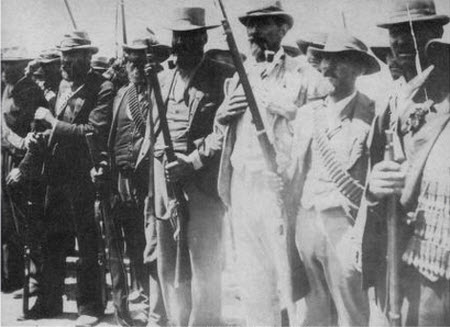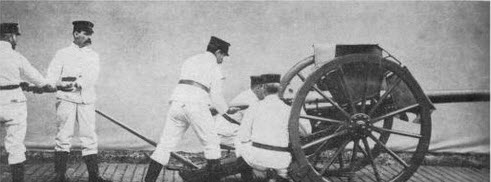While the main Boer force was engaged with the British forces in Natal, the remaining Boer units from other parts of the country also took action.
The British troops in south, in the region called Bechuanaland, were concentrated at Mafeking, but were very weak. These forces were under the command of Lieutenant General Baden-Powell, who later founded the boy scout movement. He had at his disposal 716 British troops plus 300 African Bantus. The Bantu troops were armed, but their role was only to look after the cattle which had been brought to feed the British forces, and were not intended as front line troops.


The imperial forces consisted for the following units: the Protectorate Regiment, 469 men strong, a division of the Cape Police numbering 92 men, a division British South Africa Police of 72 men and the Bechuanaland Rifles, 83 men strong. In addition there was a Town Guard in Mafeking consisting of about 300 men, but these were not regular troops and were not well armed or trained. The British had four seven pounder cannon, a couple of 12 pounder cannon, some Nordfeldt 75 mm cannon, and six .303 calibre machine guns.
The presence of Imperial troops in the area deeply concerned the Boers. The Boers were not sure how strong the British force was. They were also concerned that the British would incite the Bantu tribes to rise up against the Boers. It was therefore decided to mobilize all of the Boer militias in the western district and deploy them to the western front under the supreme command of General Pieter Arnoldus Cronje.
General Cronje had at his disposal about 6,000 men, scattered in several garrisons and commandos, the small mobile units favoured by the Boers. The Boer leadership sent Cronje orders to engage the enemy and to "attack him where you will find him, to fight and to all that is necessary to maintain the independence of the Republic".
Upon receipt of his orders, General Cronje immediately took the offensive. His first objective was the British troop concentrations along the western Transvaal border, and in particular to isolate and eliminate the British forces at Mafeking, where, according to the information of the Transvaal Government, about 2,000 men were concentrated. What followed was the Siege of Mafeking, in which the Boer forces surrounded the town and laid siege to it for 217 days, until the city was relieved by Imperial reinforcements. The Boer failure to destroy the British pocket and their defeat at the hands of the relieving British forces contributed to the unraveling of their conventional army, as they had committed their best artillery and troops to the battle. Thereafter the Boers were for the most part only able to field small irregular forces, and did not engage in massed battles against the British. The battle made Baden-Powell a national hero and his enhanced reputation helped propel the growth of the scouting movement.